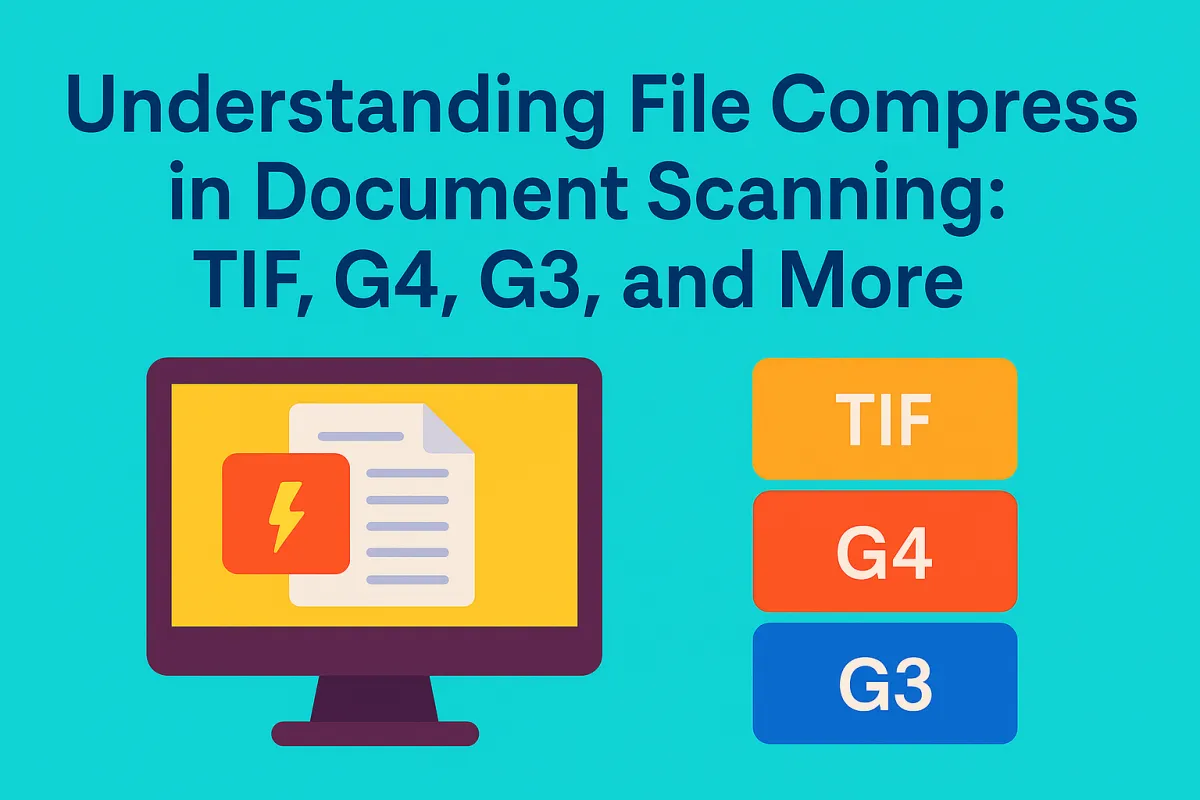
Understanding File Compression in Document Scanning: TIF, G4, G3, and More
By: USA IMAGING, Inc.
When it comes to scanning documents, especially for long-term archiving or professional use, the format and compression of your image files matter—a lot. One of the most widely used formats in high-resolution scanning is TIF (or TIFF), known for its flexibility and support for lossless compression.
But not all TIFs are created equal. Let’s take a closer look at the major compression types you may encounter—such as Group 3 (G3), Group 4 (G4), LZW, ZIP, and uncompressed—so you can make the best choice for your document needs.
TIF/TIFF: The Gold Standard for Document Imaging
The Tagged Image File Format (TIF or TIFF) is a favorite in the scanning world because it supports:
Multiple pages in one file (multi-page TIFFs)
Lossless compression
Black & white, grayscale, and color images
Widespread software support
But the power of TIF lies in how you choose to compress it.
Group 4 (G4) Compression – The Most Common for B&W Scans
Type: Lossless
Ideal For: Black & white (bitonal) documents
File Size: Very small
Speed: Fast to process and transfer
G4 compression is the most efficient method for storing black & white text documents. It reduces file size dramatically without sacrificing legibility, and it’s widely accepted by legal, government, and archival systems.
✅ Best Choice For: Invoices, legal records, forms, blueprints in B&W
🚫 Not Suitable For: Grayscale or color scans
Group 3 (G3) Compression – An Older Telecom Standard
Type: Lossless
Ideal For: Legacy compatibility with fax-based systems
File Size: Slightly larger than G4
Speed: Slower than G4
Group 3 was originally used for fax machines and supports line-by-line compression. It’s rarely used today unless specifically required for backward compatibility.
✅ Best Choice For: Specialized legal or telecom workflows
🚫 Avoid if G4 is acceptable
LZW (Lempel–Ziv–Welch) – Flexible Compression for Color & Grayscale
Type: Lossless
Ideal For: Color and grayscale documents
File Size: Moderate
Speed: Efficient and supported by most imaging systems
LZW compression retains all image quality and works well for color or grayscale images, such as photographs, old newspaper scans, or brochures.
✅ Best Choice For: Color documents where quality matters
🚫 Not ideal for large archives due to larger file sizes
ZIP Compression – Modern Alternative for Color TIFs
Type: Lossless
Ideal For: High-resolution images with minimal data loss
File Size: Often smaller than LZW
Speed: Slower compression time
ZIP compression within TIFF is newer and sometimes yields better file size reductions than LZW. However, it may not be supported by older image viewers.
✅ Best Choice For: Modern scanning environments
🚫 Test compatibility with your systems before choosing
Uncompressed TIF – Maximum Quality, Maximum Size
Type: None
Ideal For: Archival masters, medical imagery, or detailed photos
File Size: Massive
Speed: Fast to open and render
Storing TIFs without any compression ensures that no data is lost—but this comes at a huge cost in terms of file size. It’s often reserved for archival masters or where every pixel must be retained.
✅ Best Choice For: Historical preservation, medical scans
🚫 Not recommended for regular business documents
Other Variants & Considerations
JPEG-in-TIFF: Combines JPEG compression inside a TIFF wrapper. Lossy, and should be avoided for critical records.
Multi-Page TIFFs vs. Single Page: Multi-page TIFFs are preferred for scanned packets, reports, and books, while single-page is better for indexing-heavy systems.
Color Depth: Your compression options will differ based on whether your image is 1-bit (B&W), 8-bit grayscale, or 24-bit color.
What’s Right for You?

Final Thoughts
At USA Imaging, Inc., we tailor our file delivery to your needs. Whether you require ultra-efficient black & white scans in G4 format or high-fidelity color files using LZW or ZIP compression, we’ve got you covered.
Have questions about which file format is right for your project? Contact us today—we’re happy to advise.
